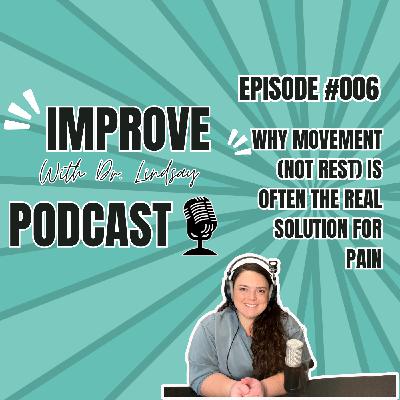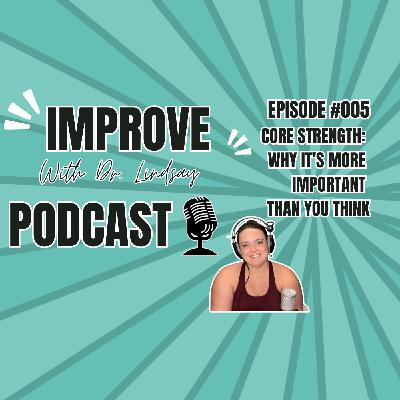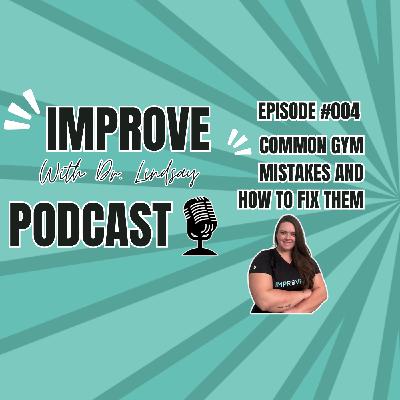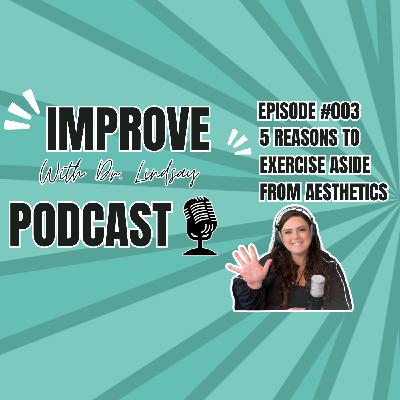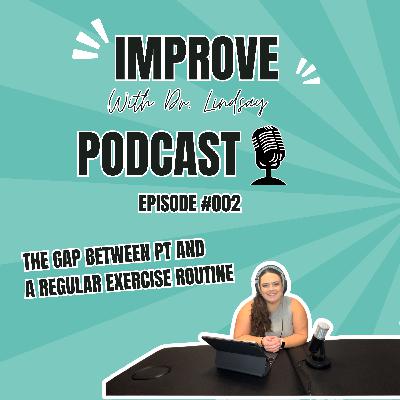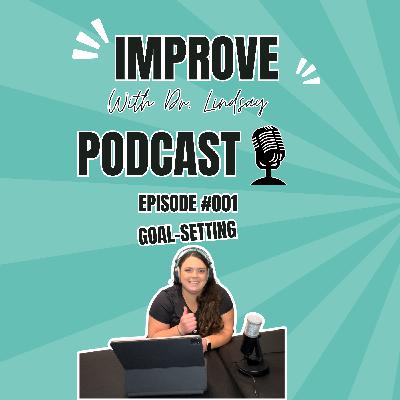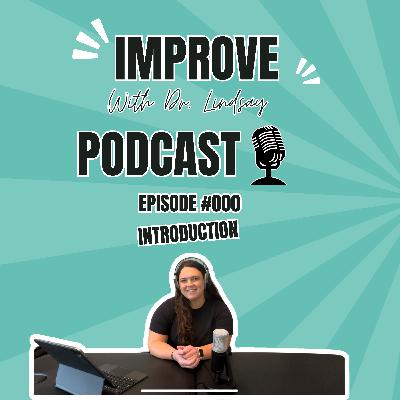Discover IMPROVE with Dr. Lindsay
IMPROVE with Dr. Lindsay

IMPROVE with Dr. Lindsay
Author: Dr. Lindsay Metivier PT, DPT, ACSM-EP
Subscribed: 1Played: 0Subscribe
Share
© 2024
Description
If you’re interested in improving your wellness (physical, mental, and spiritual well-being), then you’re in the right place!
Your host, Dr. Lindsay Metivier PT, DPT, ACSM-EP (licensed PT, Doctor of Physical Therapy, and ACSM certified exercise physiologist) will cover a wide variety of topics that pertain to how to improve your general health and wellness. Whether you are someone who is just looking to improve their health and wellness professional, there is something here for everyone!
With this channel, I hope to:
- provoke thought
- expand understanding and awareness
- inspire and motivate
- and (most of all) IMPROVE YOUR LIFE!
Your host, Dr. Lindsay Metivier PT, DPT, ACSM-EP (licensed PT, Doctor of Physical Therapy, and ACSM certified exercise physiologist) will cover a wide variety of topics that pertain to how to improve your general health and wellness. Whether you are someone who is just looking to improve their health and wellness professional, there is something here for everyone!
With this channel, I hope to:
- provoke thought
- expand understanding and awareness
- inspire and motivate
- and (most of all) IMPROVE YOUR LIFE!
7 Episodes
Reverse
Keywords movement, pain relief, physical therapy, injury recovery, chronic pain, acute injuries, brain and pain, gentle movement, healing, exercise Summary In this conversation, Dr. Lindsay discusses the paradox of movement as a solution to pain, emphasizing that despite the instinct to avoid movement when in pain, gentle and smart movement can facilitate healing. She shares personal experiences and insights from her practice as a physical therapist, explaining how the brain's protective mechanisms can sometimes make recovery more complicated. The discussion covers the importance of understanding pain signals, the benefits of gentle movement, and when to seek professional help for injuries. Takeaways Movement can be the best medicine for pain. Pain is a protective mechanism that can lead to avoidance. Prolonged avoidance of movement can lead to chronic pain. Gentle movement can help with both chronic and acute injuries. Understanding the difference between helpful and harmful pain is crucial. Movement helps manage stress and improve overall well-being. Early movement after injury can lead to faster recovery. Not every injury is appropriate for immediate movement. Listening to your body is key to recovery. Rebuilding trust in your body is essential for confidence in movement. Sound Bites "Pain makes us want to stop moving." "Movement is not the enemy." "You can rebuild trust in your body." Chapters 00:00 Movement as Medicine: Understanding Pain and Recovery 02:43 The Brain's Protective Mechanism: Pain and Movement 04:31 Decoding Pain: Understanding Your Body's Signals 06:37 The Role of Gentle Movement in Healing 08:04 Application with Acute Injuries: Input From Kylee Warne, Collegiate Level Head Athletic Trainer 09:04 When to Pause and Seek Guidance Before Moving 09:59 Empowering Movement: Building Trust in Your Body 11:24 Conclusion: Movement is Not the Enemy 11:57 New Chapter
Keywords core strength, breath control, pressure management, pelvic floor, stability, physical therapy, movement, injury prevention Summary In this conversation, Lindsay discusses the critical aspects of core strength, emphasizing that it goes beyond just having defined abs. She explains the importance of proper positioning, breath control, and pressure management in achieving a stable core. The conversation also highlights common signs of core instability and the detrimental effects of avoiding necessary movements due to fear of injury. Takeaways Core strengthening is foundational for all movements. Motor control is the first step to core stability. Proper positioning starts with being able to stacking your ribs over hips. Breath control is essential for core engagement. Pressure management is key to core stability. Avoiding certain movements can worsen the issue. Engaging the core in a 360 degree fashion is crucial for support. Functional exercises can also be a challenge on your core strength. Understanding breath dynamics is crucial in exercise effectiveness. Chapters 00:00 Understanding Core Strength 02:33 Core Strength - Role in management of low back pain 04:35 The Importance of Core Strength in Daily Life 05:50 Barriers to Core Strength Development 09:15 Understanding Proper Body Positioning 11:33 Core Strengthening Exercises 13:06 Breath Work and Core Engagement 15:11 Understanding Core Strength and Its Importance 16:09 Conclusion/Re-Cap
In this episode, Dr. Lindsay discusses common mistakes people make in the gym, emphasizing the importance of full range of motion, gradual progress, and proper load management. She highlights the significance of core engagement and bracing techniques to enhance workout effectiveness and prevent injuries. The conversation aims to provide listeners with practical tips to improve their exercise routines and achieve better results. Chapters 00:00 Introduction to Common Gym Mistakes 01:14 Lifting with Speed vs. True Strength 05:25 Not Training Full Range of Motion 07:53 Load Management: Too much OR too little 11:45 Lack of Core Integration 14:14 Doing Too Much Too Soon 16:55 Missing Out on Cardio or Resistance Training 19:08 Only Training Flexion and Extension: Our Bodies Move in ALL Directions!
On today’s episode, your host Dr. Lindsay Metivier PT, DPT, ACSM-EP is going to discuss 5 important reasons to exercise that have nothing to do with looking good or losing weight. Keywords exercise, health, pain management, cognitive function, longevity, disease prevention, physical therapy, stress relief, fitness, wellness Summary In this episode, Dr. Lindsay discusses the multifaceted benefits of regular exercise, emphasizing its role in pain management, cognitive function, longevity, and disease prevention. She highlights the importance of understanding one's motivation for exercising and how it can lead to a healthier, happier life. The discussion also touches on the physiological responses to stress and the long-term benefits of maintaining an active lifestyle. Takeaways Exercise is essential for managing pain effectively. Regular physical activity can help prevent disease. Understanding your motivation for exercise is crucial. Exercise releases endorphins that help reduce pain perception. Maintaining mobility is vital for quality of life as we age. Exercise strengthens the heart, lungs, muscles, and even your brain! What you do now impacts your future health significantly. Staying active can prevent diseases like diabetes and heart disease and can improve cognitive functions like memory and concentration. A consistent exercise routine can lead to a happier, healthier, and fuller life. Chapters 00:00 Welcome/Intro 03:33 The Impact of Exercise on Stress and Anxiety 08:09 Exercise and Disease Prevention 09:26 Exercise and Success: The High Achiever's Routine 11:36 Effects of Exercise on Longevity 14:27 Understanding Pain Management Through Exercise 16:55 Summary & Conclusion With this channel, I hope to: provoke thought expand understanding and awareness inspire and motivate and (most of all) IMPROVE YOUR LIFE! Please Visit our website to subscribe for weekly e-mail updates and blog posts. IMPROVE PT Social Media: YouTube Channel Instagram Facebook TikTok And as always, a special thanks and credit for my personalized intro/exit audio to my very talented and supportive father: Robert (Bob) Metivier.
On today’s episode, your host Dr. Lindsay Metivier PT, DPT, ACSM-EP is going to discuss the common gaps she has found between individuals being in Physical Therapy and actually being able to participate in a regular exercise routine without having to push through pain. Discussing some of the common pitfalls she has found with traditional therapies and some of the ways that she is working to fill in these gaps and help individuals that may not otherwise seek PT. As always, we are working to build awareness of the awesome things that PTs can do and help you with to help get you or keep you healthy and moving well.
Your host, Dr. Lindsay Metivier PT, DPT, ACSM-EP goes over the importance of goal-setting. Hoping to provide some education, inspiration, and motivation for others to set goals for themselves. For their health/fitness, business, personal life, and so on. Many people don’t realize the importance of goal-setting when it comes to Physical Therapy. But, it is in fact a very important piece of what we do. As Dr. Lindsay views it, it’s like drawing a road-map to success for herself and for her clients. As she has worked in the very goal-oriented fields of exercise science and Physical Therapy, There have been some common patterns of success that she has noted. She goes over these here, in hopes to provide some insight and inspiration. Goal-setting provides 1. Direction for our work and efforts 2. Keep us focused and on-track 3. Keep us motivated and feeling productive And ultimately, 4. Provide a great sense of gratification once you’ve finally achieved the goal(s) that you have worked so hard and so long for. We will also cover some other information as it pertains to Physical Therapy: Why it’s important for establishing goals to be a collaborative process with the patient Dr. Lindsay’s philosophy on an active approach to treatment. The reason PTs set goals and what we (typically) take into account as we are establishing them. and a brief explanation of the “SMART” goals acronym and an example of application to a patient scenario More on SMART goals: what they are, how to create/write them, and how to use them can be found in my blog on: www.improvephysicaltherapy.com She concludes with tying it all together, drawing a parallel between the way we write goals in PT, and how anyone can write goals for themselves. Leaving you with motivation to set and/or re-evaluate your goals and finish the last quarter of 2024 strong!
A brief introduction to your host, Dr. Lindsay Metivier PT, DPT, ACSM-EP! Tune in to learn a little bit more about me and what you can expect on this channel to come. With this channel, I hope to: provoke thought expand understanding and awareness inspire and motivate and (most of all) IMPROVE YOUR LIFE! Please Visit our website to subscribe for weekly e-mail updates and blog posts. IMPROVE PT Social Media: YouTube Channel Instagram Facebook TikTok A special thanks and credit for my personalized intro/exit audio to my very talented and supportive father: Robert (Bob) Metivier.


